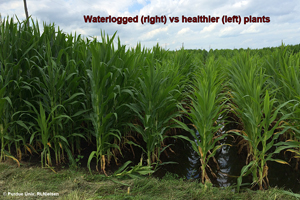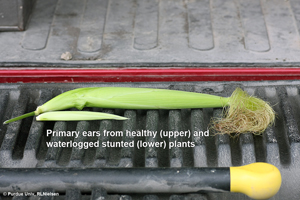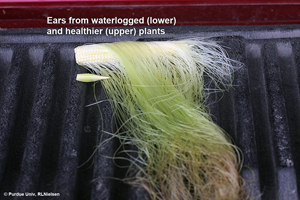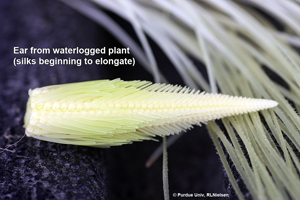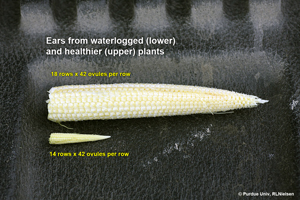
15 July 2015
URL: http://www.kingcorn.org/news/articles_15/TwoEars_0715.html
Waterlogged Corn: A Tale of Two Ears
R.L. (Bob) Nielsen
Agronomy Dept., Purdue Univ.
West Lafayette, IN 47907-2054
Email address: rnielsen
at purdue.edu
One of the concerns with the seemingly incessant ponding or saturation of corn fields around Indiana early this growing season is that the stress imposed by waterlogged, oxygen-deficient soils on corn plants during their rapid growth phase will reduce the ear size potential. If true, then yield potential will be limited regardless of whether the weather moderates for the remainder of the growing season.
The uppermost primary ear of a corn plant is initiated at approximately growth stage V5 (five leaves with visible leaf collars). The maximum number of potential kernel rows (ear girth) on the ear is complete by about V7. Subsequent initiation of ovules for each row (ear length) occurs sequentially from the base of the cob to the tip over several weeks. Ear size determination is thought to be complete by V12 to V14. Severe stress occurring during ear size determination can decrease the potential ear size (reduced ovule numbers). See my 2007 article for more information and photos (Nielsen, 2007).
Ovule row number determination is relatively tolerant to stress due, in part, to it being a relatively strong hereditary trait and also because maximum ovule row number determination occurs over a relatively short time period (2 to 3 leaf stages or about 6 to 9 days). Ovule number per row is relatively more vulnerable to stress for the opposite reasons... less of a hereditary trait (more responsive to growing conditions) and a longer time period for development (more opportunity to experience severe stresses).
Interestingly, our research with corn responses to nitrogen (N) fertilizer rates and plant populations suggests that ear size determination is relatively unaffected by severe N deficiency or excessively high plant populations during the vegetative stages of development. Yield reductions due to either stress are due more so to reductions in actual kernel number (pollination failure and kernel abortion) and kernel weight.
So, what about the stress imposed on plants when they are faced with saturated soils or outright ponding during the ear size determination period? We do not have much data at all on this, but I checked some plants the other day in a partially ponded field to obtain some serendipitous, non-replicated data. The accompanying photos illustrate what I found in this limited sampling of plants. Take it with two grains of salt.
I removed silking ears from three random relatively healthy plants in a relatively unaffected area of the field and lesser developed ear shoots from three random stunted plants from an area that has been ponded and saturated multiple times since early June. The latter plants were certainly not as severely stunted as some of what we see around the state these days, but neveretheless represent quite a bit of the stunted corn that one might consider salvageable (Nielsen, 2015).
The development of the ear shoots removed from the stunted, waterlogged plants was distinctly delayed relative to those from the healthier plants. The latter were in the early stages of silk emergence (R1), while those of the nearby stunted plants were only in the initial stages of silk elongation within the husk leaves. Silk emergence of the stunted plants will likely be at least a week delayed.
Surprisingly, ovule numbers per row were identical between the ears of the healthy and stunted plants (42). Considering that kernel numbers per row at harvest typically range from 30 to 35, those ovule numbers are certainly acceptable and fairly normal.
However, ovule row numbers were less on the ears from the stunted, waterlogged plants (14 versus 18). Specifically, the ovule row numbers at the very base of the cobs were the same as the healthy ears, but within a few ovules from the base of the cobs, two pairs of ovule rows "disappeared".
Ovule paired rows initially develop as single spikelet primordia rows that eventually divide into pairs as ovule development proceeds from base to tip of the cob during ear size determination. With the ears from the waterlogged plants, it appears that two spikelet primordia rows (potential paired rows) appeared to have simply aborted shortly after they were initiated. This circumstantial evidence suggests that, in addition to being waterlogged recently, these plants were also waterlogged near the V7 growth stage and stressed enough to cause the abortion of potential kernel rows very early in their development.
That may be more than you cared to read about, but the upshot of situations like this is that the potential loss in yield potential from aborted rows of potential kernels can be quite large. Using the traditional yield estimation formula (Nielsen, 2014) and a harvest population of 32,000 ears per acre, one can estimate the potential yield loss.
For the sake of argument, I will further assume that a "typical" 18-row ear of corn would have no more than 30 harvestable kernels at a population of 32,000, while a "typical" 14-row ear often has upwards of 35 harvestable kernels. Given those assumptions, the potential yield of the healthier plants in the field would be about 216 bu/ac (18 x 30 x 32 divided by 80) while the potential yield of the stunted plants (assuming equal kernel weights) would be about...................... 196 bu/ac (14 x 35 x 32 divided by 80). Certainly, one can play various "what if" scenarios with the yield estimation formulas by changing harvestable kernel numbers and kernel weight (fudge factors), but nevertheless the closeness of the yield estimates is astounding.
Among the unknowns with such estimates are a) whether the eventual pollination in the stunted and delayed ponded areas will be successful, b) whether kernel abortion rates will be significantly higher with the stunted plants, and c) whether kernel weights will be compromised due to the stunted plant development. Additionally, there is also the lingering question about whether available soil N is adequate to sustain kernel development in the waterlogged areas of fields.
A lot of unknowns, but that is par for the course when faced with the extreme weather events like we are experiencing in 2015.
Food for thought. Take it for what it is worth.
Related reading
Nielsen, RL (Bob). 2007. Ear Size Determination in Corn. Corny News Network, Purdue Extension. http://www.kingcorn.org/news/timeless/EarSize.html [URL accessed July 2015].
Nielsen, RL (Bob). 2014. Estimating Corn Grain Yield Prior to Harvest. Corny News Network, Purdue Extension. http://www.kingcorn.org/news/timeless/YldEstMethod.html [URL accessed July 2015].
Nielsen, RL (Bob). 2015. Salvageability of Waterlogged Fields of Corn: That's the $64 Question. Corny News Network, Purdue Extension. http://www.kingcorn.org/news/articles_15/WaterloggedCorn_0707.html [URL accessed July 2015].

